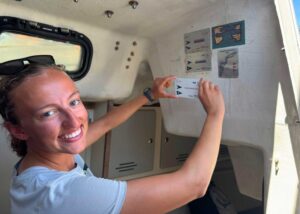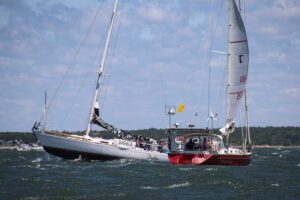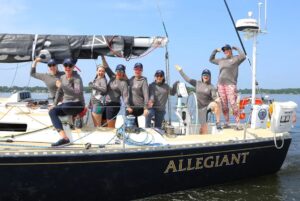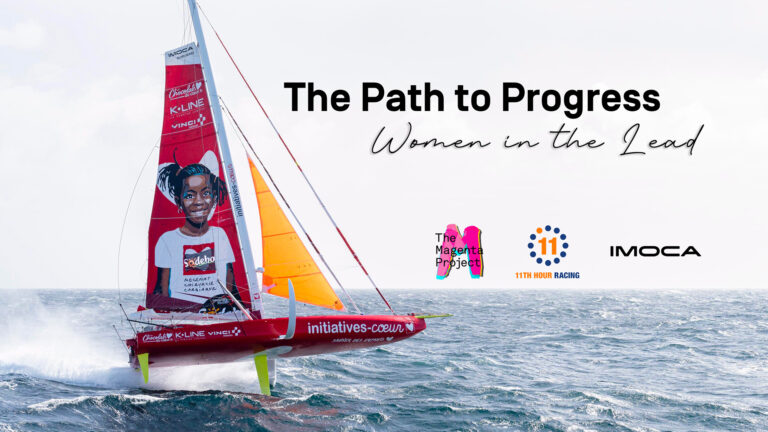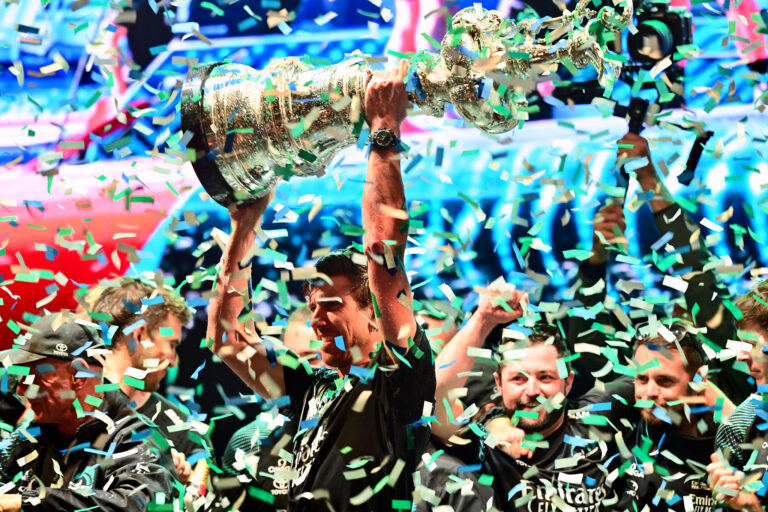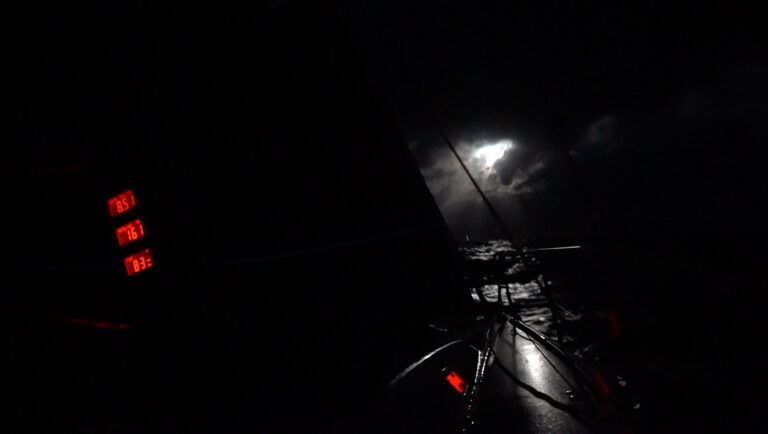It’s mid-December, and I’m more than 3,500 miles from Cape Town, South Africa, bound for Fremantle, Australia, having—at the moment—too much fun. Indian Ocean conditions are near perfect with 15 to 17 knots of wind at an apparent 120-degree angle. With 10-foot rolling waves, it’s a textbook surfing recipe for keeping the Clipper 70’s boatspeeds averaging 11 to 12 knots to maintain our sixth-place position in the Clipper Race fleet.
We’ve been given a heading with instructions to “go f-ing fast.” I’ve been searching aggressively for good surf and getting the boat up to windspeed, but this has led to an off-course trend. As if on cue, Lottie Wade, the boat’s 27-year-old professional first mate, or Additional Qualified Person (AQP) in Clipper Race parlance, appears at the companionway. She deftly performs the tether dance, quickly clipping and unclipping her two safety tethers so she constantly remains attached to the boat while moving around six or seven crew and through 20 feet of cockpit. She dives under the mainsheet traveler popping up next to me at the helm.
“I’m seeing a lot of 30s on COG,” she says with her “Stokie” British accent, referring to the course over ground heading. “We need 50, come up.”

Photo courtesy of Steve Titus
Lottie is a badass, unintimidated by the Type A middle-aged men and other pretentious crew aboard CV29, aka PSP Logistics. She also instigates a lot of fun; we are lucky to have her as AQP. Her demand for the higher heading means living on the edge with our Code 2 spinnaker at a 90-degree wind angle, so we suffer a few flogs on my way to finding the new groove. After 10 hours, we approach the final turning mark nearly 20 miles from the finish line of Leg 3 of this circumnavigation and are about to drop the spinnaker. Our nine-person watch crew is scurrying around the cockpit getting ready for the evolution. Red-light headtorches flash across lines and winches in the early-morning darkness. Everyone is tired and ready to be on shore, but the mood is light with promises of warm weather, level beds, and the pub.
Like other crew who have family meeting them, I’m looking forward to seeing my son, Reece, and having him join the crew for the next leg to Newcastle and then the Whitsunday Islands. A couple of days ago, he completed his last college exam and jumped on a plane to meet me and the boat. This father-son adventure—one full leg of the Clipper Race together—is a mutual exclamation point in our individual crossroads: for him, the end of college, for me, imminent retirement.
“C’mon guys, let’s go, who’s on the halyard, who’s on the tack,” gripes Andrew Moss, a watch leader who’s doing the whole circumnavigation rather than individual legs. “We should already be there,” he says with typical annoyance in his voice. Andrew has a lifetime of sailing experience and has mastered the details of the Clipper 70. He is the most qualified paying member of the crew. Our similar sailing experience often leads to arguments about sail trim, tactics, and helming style.

Photo by Meredith Rodgers courtesy of Clipper Ventures
This time our professional skipper, Mike Miller, is at the helm and he calls out for status at each station. “Foredeck ready?” They affirm. “Mast ready?” Another affirmation. “Cockpit ready?” We’re set to drop the tennis-court-sized sail and Mike calls, “Blow the tack.”
Normally the tack line is quickly released and triggers a snap shackle so the spinnaker tack flies freely. Not this time. The tack line runs out, but the shackle doesn’t release. The pit crew also begins dropping the halyard, but without control of the tack the sail drops in the water and is dragged under the boat. This is not the first or the last time we will fight with the spinnaker.
Little emergencies like this, and how we manage them, punctuate and sometimes define the sailing experience aboard a Clipper 70. Ours is one of 11 identical yachts built specifically to race around the world in extreme conditions. The boat is a beast, similar to the Volvo 60 but overbuilt to shake off the abuse inflicted by a crew of tired amateur sailors in difficult conditions. There’s nothing comfortable, everything is heavy, everything can hurt you, and there are no hydraulic aids or roller furling to manage sails.
One-design ocean racing like this is typically highly sponsored and professionally crewed. The Clipper Race is unique. In September, the fleet departed Portsmouth, England, each boat sailing with a professional skipper and mate and a crew of 20 amateur sailors who’d completed four weeks of training for the 40,000-mile journey around the world. Now in its 13th edition (2023-24), it’s the longest and most grueling semi-professional crewed yacht race in the world. Sailed in eight legs on a cumulative point system, it’s a logistical puzzle of personalities, physical abilities, and sailing skills. (“Into the Wild,” November/December 2023).
After a little shrimping with our Code 2 spinnaker, we successfully recover the sail with surprisingly little damage. However, this mistake cost a couple of positions and we finish in eighth place. Dockside celebrations in Fremantle are blunted by a 2 a.m. arrival and a strict Australian immigration policy that requires an agriculture inspection and customs processing before the crew can leave the vessel or have physical contact with anyone ashore. After 25 days at sea, this is a major letdown as Reece is standing two feet away and all I want is a hug—and a beer.

Into the Maelstrom
The next five days on shore exploring Fremantle and preparing the boat for Leg 4 pass quickly, and on December 22 we slip lines and head south for the trip around Cape Leeuwin and Tasmania to our first stop in Newcastle. The sendoff is typical Clipper pomp with supporters and well-wishers lining the docks and spectator boats chasing the fleet around the start area. With just a few minutes to the start, a Clipper bosun is making final repairs that we didn’t have time to accomplish on shore. A RIB pulls alongside, and he climbs off as we sail toward the start line.
We are well organized and have spotted a clear range mark for the line. I’m on the bow calling distance to the start and providing a heads up for approaching competitors and spectator vessels. With 30 seconds to go we are nicely positioned with a clear hole to make the start line.
“Grind the Yankee,” Mike calls out as the time comes to power up for the line. Reece is on the pedestal grinder with another crew member cranking in our largest headsail.
“Grind, grind, grind!” Mike calls out. I’m at the bow calling the trim, turning my index finger over my head, the signal for sheeting in the Yankee.
“Three boatlengths,” I call out while counting down to the start gun. “Five, four, three.” Mike comes up hard on the wind, the gun sounds, and we cross the start line with the entire fleet in our wake. This is every racing sailor’s happy place, and the 18-strong crew shouts a collective cheer as the race director calls all clear over the radio and gives us some public kudos for our winning start.
The instant gratification is short lived. Over the next 24 hours we get down to the serious business of offshore sailing. We settle into our two-watch system of six hours on and six off during the day and four on, four off at night. Within a few hours the breeze builds, and we turn south into a steady headwind and 15-foot seas that will stay with us for days—a very tough way to start that lays out two-thirds of the crew with seasickness, including Reece. My acclimation during the leg from Cape Town spares me the green monster, but I’m left to run the boat with the six or seven other healthy crew.

The wind and waves continue to build, and we are constantly taking water over the bow, with the odd side-wave filling the cockpit and sending water down the companionway. Over the last 3,800 miles, I’ve developed “helm elbow” and the joint in my left arm clicks and aches until I’m steering with one hand and one foot. Any romantic notions the new crew had about sailing are shattered by the reality of constant noise, cold, wet, and crowded conditions below deck, along with debilitating seasickness. Reece is on my watch, and it’s painful seeing him repeatedly rush to the rail. Stints on the helm give him some relief, but once off he’s back to monitoring the boat’s wake at the stern rail.
Despite the grim conditions, we are still racing. We keep an eye on AIS as each boat chooses the speediest route to the southern tip of Tasmania, our gateway to warmth in the north. That’s still nearly 2,000 miles away and we are in for a bit of everything between then and now.
Merry Christmas and Happy New Year
As is the norm, in about 48 hours the mal de mer eases and the boat is back to nearly full strength. Gradually the upwind battle slackens as an approaching high pressure system brings more moderate conditions and the challenge of finding a path around the wind holes that can create huge leads for boats that escape. A majority of the fleet continues heading below 42 degrees looking for bigger wind, while a few of us, including Perseverance, one of our closest competitors, stay north in lighter wind but a much shorter course.

We wait impatiently for the 12-hour weather updates delivered to the fleet by the weather router based in the UK, hoping for good news on our course strategy. Sadly, a wind hole chokes off our eastbound path. We helplessly watch the more southern boats rack up 225-mile days while we scratch 120 miles or less out of the dying breeze.
On the positive side, the light wind makes holiday celebrations and a white elephant gift exchange more relaxed; practical and goofy offerings include a 3-foot tall stuffed cat, rubber fish slippers—very popular—and a keychain made from kangaroo testicles, which Reece takes home. But as we angle south looking for wind, the temperature drops, and after almost four days of light air, a low pressure system finds us—with a vengeance.
The clockwise spinning system carries wind from cold Antarctic waters and pushes up taller waves. Gale stripes streak the water as the wind rises above 30 knots, and we’re now reaching under a reefed main and Code 3 spinnaker, finally making good time and looking for a path out of ninth place. This is an aggressive sailplan, and it makes driving more challenging, but after a little peer pressure, Reece steps up to the helm cage. Andrew is a good coach and is at Reece’s shoulder giving him regular feedback. Normally Reece has a relaxed one-handed helming style where he leans back and puts one arm around the back of the cage like a girlfriend is riding shotgun. This time he has a vice-grip on the wheel and a stern look as boatspeeds approach 20 knots.
“Feel the wave coming, bear away, not too much,” Andrew says. The boat lifts and heels a bit more before surfing down the wave and getting a few cheers from the on-deck crew enjoying the ride.
“Head up now, up, up, up,” he says as the boat has overrun the asymmetrical spinnaker and it folds around the headstay. “Grind, grind, grind!” Andrew yells to the pit crew and they jump to the pedestal grinders to tighten up the flogging spinnaker.
It’s not enough, and the wrap worsens as the mast swings at the bottom of the swells. I’m coming up the companionway just as Jessica, one of the circumnavigating crew members, screams at the top of her lungs directly into my face, “All Hands On Deck!” Veins are bulging on her neck and forehead, teeth bared, looking like a pirate ready to board a privateer. But just at that moment, the magic of wind and waves lends a hand, the wrap slips out, and the sail fills. Belay that bellow. I wipe the spit from my forehead and carry on.
Despite the mishaps, we are knocking out 240-mile days with favorable wind conditions forecast to continue in the 600 miles remaining to Tasmania. We’ve been on one tack for a few days, the wind is increasing, and it’s time for a rig check. Lottie dons the harness, helmet, and “The Madonna,” a two-way headset used to communicate with the deck while she’s aloft. We grind her up the 96-foot mast for a look around.
“We have a problem,” she says shortly after reaching the masthead. “The spin block is cutting the halyard.”
The 6-inch-wide sheeve wheel holding the port spin halyard has been chafing against the mast and has broken, creating a sharp edge that cut through the halyard casing, leaving only the core. In addition, the masthead tab holding the sheeve is cracked. We send up the starboard halyard and switch over, averting disaster—for now—but we will be dealing with this problem again.

Sailing Nirvana
By day nine of this leg, it’s New Year’s Eve and we have rounded Tasmania, turning north toward Newcastle. Tonight’s 2200 to 0200 watch, usually exhausting, is the most exhilarating of the race. The wind is 15 to 20 knots with long rolling waves and clear skies. The Milky Way extends fully from one horizon to the other, so dense with stars it’s like looking out from a snow globe. At midnight a glow appears on the bow. At first we think it’s another boat, but in a few minutes the sliver of moon appears laying down a lighted highway across the waves.
The 120-degree wind angle and C3 spinnaker create the perfect surfing combination, and my entire stint on the helm is sailing nirvana catching wave after wave. Each time the boat surfs, the helm gets light and a wake forms at the bow that moves back along the hull as the speed increases and the roaring wave drowns out the wind. Long offshore passages lead to a mixture of emotions ranging from utter despair to euphoria. These rare and remarkable moments make all the suffering worthwhile, and it’s a big reason many of us attempt these journeys.
All good things must come to an end. As we turn north, high pressure to our northeast delivers 35-knot headwinds across the deck compounded by a 3-knot opposing current lasting more than 100 miles that we must cross. For the next three days, we’re back to 45-degree heel, rail in the water, and a miserable crew. We are in seventh place, a dismal showing for the work invested. We just want to get there, and little mistakes make everyone irritable.
“It’s all about the journey, at the end of the day. It’s all about the adventure,” Lottie says to me as we discuss the situation. “We may not be doin’ good, but it’s a bloody good adventure.”
Adventure is the word, and as we approach Newcastle, we make a westerly turn towards shore allowing us to carry a spinnaker. With 40 miles to go we are battling with two other boats for seventh place, and they are barely 11 miles behind. We’re feeling comfortable with the gap, and our boatspeed under the Code 2 is a full knot faster than the competition until…“All hands on deck!”
The call you don’t want to hear comes from the cockpit. The spinnaker is in the water and dragging behind the boat while still attached at the clew and the tack. The two Dynema strops holding the masthead halyard block have chafed through. The crew lines the rail trying to winch and drag the giant sail full of water back onto the deck. For 30 minutes, we haul bits of the sail over the rail, only to have it dragged back into the sea. It’s still in one piece but in danger of major damage so we bring the boat to a halt and recover the soaked sail. Despite the fumble, we maintain our position and finish in seventh place.

The Final Countdown
The first part of this leg from Fremantle to Newcastle was tough enough to cause one crew member to abandon the rest of the race. The next 1,000 miles to the leg’s end at Airlie Beach in the Whitsunday Islands won’t come with the huge waves or the headwinds, but we’ll have a new challenge: heat.
Our start from Newcastle is in a busy, narrow channel to provide maximum viewing pleasure for shore-bound fans. This means the committee boat is anchored 100 feet from shore and the pin is a channel marker with water too shallow to navigate on the outside. It’s a tough start, but once again we time things perfectly and start with the fleet in our wake. Funny thing about those channel markers is they all look alike. In our haste to make the start, we use the wrong one as our pin, leading to a two-hour penalty for being over early.
“Bloody hell,” says Mike, the skipper, under his breath. “Well, it’s still great fun seeing the fleet in our wake; less to hassle with in this channel. Let’s carry on.”
While this was disappointing, it’s oddly reassuring to see that someone with more than 200,000 miles in his logbook can still make mistakes. Mike is constantly optimistic and no matter the difficulty or discomfort always has a smile. He also has the remarkable talent of being able to sleep in nearly any position or place on the boat; the crew has a huge collection of pictures with Mike sleeping at parties, in the pub, at the chart table, or in the galley with a fork full of food in his hand. Then he can spring to action, fully awake, at a moment’s notice—the ultimate offshore sailing skill.
Sleep will come at a premium for the rest of us during this race. Below deck it’s more than 110° F and all starboard bunks bake in the unshaded tropical sun. Rain squalls add some work with sail changes but give us a welcome break from the heat.
Reece and I have been placed on opposite watches, dubbed Father Watch and Son Watch. It’s too hot to sleep during the day, so I spend my off watch on deck in any unoccupied patch of shade and watch Reece interact with the crew who are all twice his age. He’s an impressive character and is well liked by even the most difficult personalities. His sailing skills have also improved, and he naturally takes leadership roles during evolutions. I’m accustomed to being athletic, but at 63, things don’t come as easily as they once did. Reece is stronger and more nimble, and it’s immensely satisfying to watch him so easily summon his abilities.
We are comfortably in sixth place, even with our penalty, but with about 50 miles to go and only an hour into my 0200 to 0600 nap, there’s another call for all hands on deck. The Code 2 spinnaker is giving us grief and a squall has led to a massive hourglass wrap around the forestay. We are still 19 miles ahead of Punta del Este, our nearest competitor, but our two-hour penalty is becoming an issue, and we could easily lose one or even two places with this mistake.
The gusty 25-knot winds make the wrap worse, and Lottie is forced to go up the mast. It’s a dangerous procedure in daylight, but at 3:30 a.m., in the pouring rain, it’s the scariest moment of the entire 7,500-mile journey. It takes her more than 25 minutes aloft to disentangle the sail enough to bring it down and get us under way. With our lead diminished, the decision is made to hoist the Code 3. Within minutes of raising the sail, a squall-induced wind shift causes another wrap, marking an end to our spinnaker sailing for the evening.
All of this faffing about has cut our lead to less than 10 miles. But our final stretch to the finish is blissful sailing through the Whitsunday Islands in flat turquois water. The crew takes turns driving with Justin, a hometown Aussie, helming us across the line at 6:45 a.m. We wait and watch our finish position drop to seventh, then eighth as our competition crosses the line ahead of our two-hour penalty.
Yet this is of little consequence as we approach the dock full of friends and family cheering us on. It’s a reminder that the important thing is the journey, the adventure, and the personal satisfaction of reaching this remarkable place with a son who is far greater than I was at his age and destined to be greater than I am at my age.

Photo by Meredith Rodgers, courtesy of Clipper Ventures
May 2024


